
Are Autonomous Vehicles Actually Safe? The Answer may Surprise You
It wasn’t very long ago that self-driving cars seemed like something out of a science-fiction movie. Today, prototype vehicles are already on the streets, and it may not be much longer before autonomous vehicles are in every garage. Children born today may never need to learn how to drive a vehicle. But while that day may still be a few decades away, the question for today is about safety. Can autonomous vehicles be created that are truly safe? What safety concerns are there, and how can those concerns be addressed?
Data Confirms Autonomous Vehicles Are Safe
First, let’s look at some of the data surrounding autonomous vehicles. While still in early testing, these vehicles have already driven more than two million miles. The number of accidents is quite low. In fact, autonomous vehicles have been determined to be at-fault in very few crashes. The number of times drivers who fell into the safest demographic (those between age 60 and 70) were determined to be at-fault was almost ten times higher than that of self-driving cars.
When compared to new drivers, that rate quadruples. For every one self-driving car determined to have caused an accident, there are 40 teenagers who were at-fault. Car accidents are the leading cause of teenage death in the U.S. As many as 8,000 fatal car accidents are caused by drivers between 16 and 20 years of age. With a much lower accident rate, it’s easy to see that autonomous vehicles are safer than young drivers.
Yet many news outlets still report on the number of crashes within which self-driving vehicles are involved. There are several facts, however, which are often left out of these reports. First, human drivers were determined to be at-fault who did or did not do something that led to the accident. Second, the self-driving cars are programmed to obey all traffic laws. This means they brake at crosswalks and for pedestrians, yield when it’s appropriate, and always stay under the speed limit. Human drivers don’t. Even those who rarely speed may not always brake when they are legally required to do so.
Finally, the vast majority of accidents that did involve a self-driving vehicle were generally “fender-benders.” There was no major damage done to any of the vehicles involved, nor was anyone seriously injured. Compare this to the five fatalities that occur every hour due to automobile accidents, and the simple fact is that self-driving vehicles are safer.
Trusting the Technology
Unfortunately, many people aren’t quite ready to make the jump to self-driving cars, no matter how safe they appear to be. Part of this resistance is simply the fear of anything new. People don’t automatically trust new technology, especially when that technology is responsible for keeping them safe. They want to see more proof that self-driving vehicles are better on the road than cars driven by humans. No matter what the numbers say, they won’t convince these people.
Others worry that self-driving vehicles will negatively impact the economy. Will car dealerships be forced to close? How will body shops and insurance agencies be affected? It’s true that self-driving cars are likely to affect these industries in a number of ways. They will also impact technology industries, city infrastructure, and much more. The technology will have a ripple effect through many industries, but it won’t be the first innovation to do so. The introduction of the affordable computer, the widespread use of the internet, and the telephone all had major impacts on the economy and society in general. Autonomous vehicles will certainly do the same.
Making Autonomous Vehicles Widespread
The technology to create self-driving cars is already here and, as proven by a number of prototypes, is more than viable. It’s safe and reliable, and while its economic and social impact has not yet been fully determined, there’s really no turning back. The only question is how will self-driving vehicles be implemented?
One answer to this question is small cells and the 5G network. The 5G network isn’t available yet, but the technology is there. This network is much faster and more reliable than today’s 4G. It can handle connections to many more devices without lag or dropped signals. The only downside is that the signal cannot be broadcast as widely as 4G, so cities will need thousands of short-range 5G transmitters throughout.
That’s where SYNDÉO and the Smart Vault come into play. The Smart Vault is a small protective housing installed in under ADA curb ramps, sidewalks and street terraces. This housing contains 5G transmitters and all of the wiring needed to power them and connect them to the network. By regularly placing Smart Vaults throughout a city, urban planners can create a zone of coverage that can be used to help guide autonomous vehicles through urban streets. This type of network will be necessary for large metropolitan areas that see thousands of cars on the streets every day.
By using Smart Vaults in combination with the 5G network, cities can create a network that will let smart cars continually exchange information with each other. That, in turn, will avoid accidents and show, once and for all, that autonomous vehicles are, with the right technology backing them, safer than human drivers.

